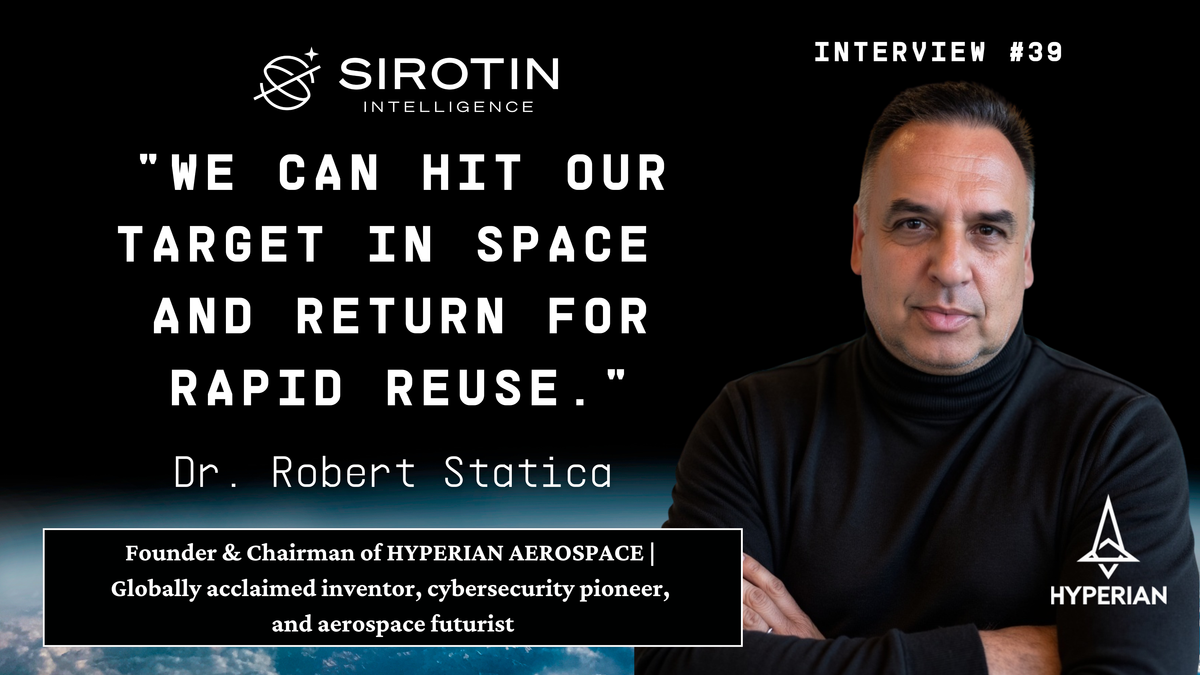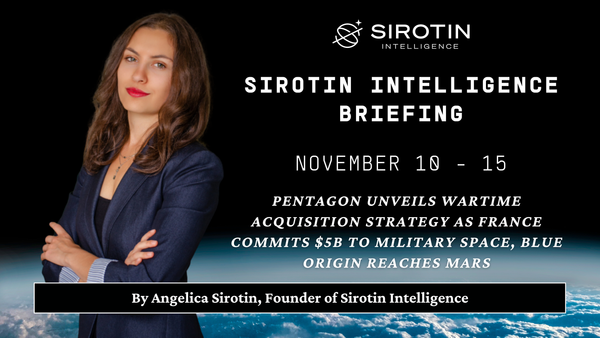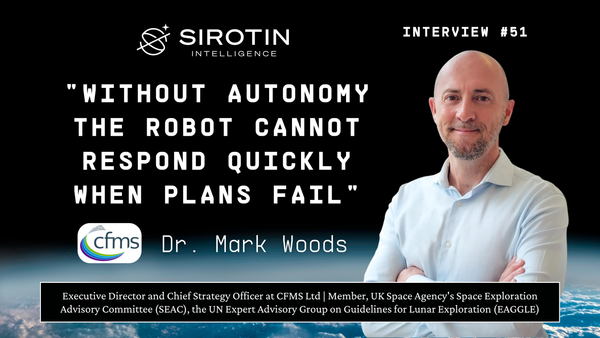"We Can Hit Our Target in Space and Return for Rapid Reuse": Dr. Robert Statica on Building Hypersonic Aircraft, Space-Based Defense Systems, and the Race to Sub-$100/Kg Space Access
Hypersonic planes, AI-powered interceptors, and $100/kg space access—Dr. Robert Statica is turning sci-fi into aerospace reality.

Aircraft that cross continents in 90 minutes. Rockets that take off like planes and return from orbit intact. Space-based interceptors hunting threats at 17,500 mph.
Dr. Robert Statica, Founder & Chairman of HYPERIAN AEROSPACE, isn't building science fiction. He's engineering these capabilities into reality. With over 25 years spanning NASA missions, defense contracts, and groundbreaking cybersecurity innovations, Statica represents a rare breed of technologist who has successfully translated government-scale engineering into commercial viability.
His portfolio reads like a catalog of technologies borrowed from tomorrow: the BLACKSTAR Mach 10 hypersonic fighter, the HYPERLINER passenger aircraft, and the HYPERSPACE platform that promises sub-$100/kg space access. These aren't incremental improvements. They represent paradigm shifts that could redefine national defense and commercial space operations.
As the commercial space sector rapidly expands and space becomes increasingly militarized, Statica's dual-use technologies offer a glimpse into a future where the barriers between Earth and orbit dissolve, where space-based defense becomes routine, and where reaching space transforms from aspiration to infrastructure.
I sat down with this aerospace futurist to explore how his technologies could reshape everything from morning commutes to missile defense, and why he believes we're on the cusp of an orbital revolution that will make today's space industry look quaint by comparison.
Given your development of both the HyperSpace SSTO vehicle and the HyperSpace Interceptor/Fighter for orbital defense, how do you envision the integration of commercial space access with national security space assets? What are the key technical challenges in scaling single-stage-to-orbit technology for both civilian satellite deployment and military space defense applications?
"With the HyperSpace SSTO and HyperSpace Interceptor, we're redefining the future of orbital infrastructure. These aren't just vehicles—they're platforms built for dual-use readiness, capable of launching civilian satellites, conducting ISR, or intercepting space threats—all from a horizontal takeoff and landing system."
Statica's emphasis on "dual-use readiness" reflects a sophisticated understanding of modern aerospace economics. Single-stage-to-orbit (SSTO) represents one of aerospace engineering's most challenging goals. Unlike conventional multi-stage rockets that jettison components during ascent, SSTO vehicles must carry all propulsion systems to orbit and back. The concept has been pursued since the 1960s, with notable attempts including McDonnell Douglas's Delta Clipper-X program in the 1990s and more recently, companies like Skylon with their SABRE engine technology.
The Race to Affordable Space
From $54,500/kg to Sub-$100/kg: The SSTO Revolution
No launch towers • No recovery ships • No expendable stages
Deploy from any military-grade runway worldwide
Expendable stages
Complex recovery operations
Weather-dependent
Fully reusable vehicle
Aircraft-style operations
Rapid turnaround
becomes infrastructure, not aspiration."
mass satellite deployment become financially viable for universities and startups
"The core challenge in scaling SSTO lies in energy efficiency and mass optimization. Traditional rockets rely on disposable stages and massive vertical infrastructure. Our SSTO does the opposite: one integrated, reusable vehicle that reaches orbit and returns intact. But to make that viable, we have to manage one of the most critical variables in orbital mechanics: delta-v."
The concept Statica describes as "the most critical variable" is fundamental to all space operations. Delta-v, short for "change in velocity," quantifies the total velocity change required for any space mission. According to NASA's orbital mechanics principles, reaching Low Earth Orbit from Earth's surface requires approximately 9.4 km/s of delta-v when accounting for atmospheric drag and gravity losses. The Apollo program, for comparison, required roughly 16.5 km/s of total delta-v for the complete Earth-Moon-Earth journey.
"Delta-v—short for ‘change in velocity’—is the fundamental metric that determines how much thrust or propulsion is required for a spacecraft to perform any maneuver in space. Everything—launch, orbit change, target interception, or reentry—requires a specific delta-v budget. Our AI-powered flight systems are constantly managing this budget, calculating the most efficient way to insert payloads, execute burns, and return for reuse. It's like optimizing every move in a chess game at 25,000 km/h."
Statica’s chess analogy gains weight when placed against the backdrop of dramatic cost reductions his approach enables. The economics of space launch have improved dramatically in recent years. According to NASA's analysis, space shuttle missions cost approximately $54,500 per kilogram to Low Earth Orbit. SpaceX's Falcon 9, through first-stage reusability, has reduced costs to roughly $2,720 per kilogram as of 2023, representing more than a twenty-fold improvement over previous systems.
"While today's launch providers charge around $1,500 to $3,000 per kg, with SpaceX pushing below $1,000/kg, HYPERIAN AEROSPACE is engineering for orbital delivery at under $100/kg. This unlocks mass deployment of commercial and military payloads with minimal delay and cost. And because we operate from any military-grade runway, not a launchpad, we're building a globally deployable launch capability for Earth and beyond."
Delta-V: The Currency of Space
How AI-Powered Systems Optimize Every Movement in Orbit
how much thrust is required for any maneuver in space
Our AI doesn't just chase; it ambushes, calculating when and where
to intercept with minimal energy expenditure."
and enables rapid reusability for space-based defense systems
You contributed to NASA's Stardust mission as one of the first sample return missions, and now you're developing SpaceAI for autonomous deep-space navigation. How has your perspective on space exploration evolved from those early sample return missions to today's AI-driven approach? What specific lessons from Stardust influenced the development of SpaceAI's autonomous systems?
"Looking back at Stardust and after analyzing the entire mission, I realized it was a turning point—not just for NASA, but for me personally. It proved we could reach into deep space, retrieve something, and return safely. But back then, missions were pre-scripted down to the smallest detail. You couldn't adapt in real time."
The "turning point" Statica describes represents a fundamental shift in how we approach space exploration.NASA's Stardust mission, launched February 7, 1999, marked a milestone in space exploration as the first U.S. mission to return extraterrestrial material since Apollo 17 in 1972. According to NASA mission records, Stardust traveled nearly 5.7 billion miles over twelve years to collect particles from comet Wild 2's coma and return them to Earth for analysis.
"That's the exact gap SpaceAI is built to close. With SpaceAI, our spacecraft no longer rely on ground control for every decision. They think. They adapt. They reroute. They survive. The goal isn't just exploration anymore—it's operation in space: persistent, autonomous presence."
Statica's vision of spacecraft that "think" addresses one of the fundamental constraints of deep space operations.Traditional space missions operate with pre-programmed command sequences due to communication delays that can exceed 20 minutes each way for deep space missions, according to NASA's Deep Space Network documentation. This delay makes real-time control impossible for distant spacecraft operations.
"Stardust reports and findings taught me that resilience and timing are everything in deep space. One miscalculated burn and you miss the window—or worse, lose the craft. That understanding is baked into SpaceAI's DNA: real-time situational awareness, predictive anomaly detection, and autonomous navigation powered by live data fusion."
"We've gone from preloaded logic to real-time reasoning. SpaceAI isn't just the next step—it's the leap we needed to build intelligent spacecraft that can operate indefinitely, far beyond Earth's line of sight."
Your HyperSpace Interceptor represents a novel approach to defending against missiles and rogue satellites in LEO and MEO. Can you elaborate on the technical framework for space-based interception systems? How do you address the orbital mechanics challenges of intercepting targets across different orbital planes and altitudes?
Hyperliner in Suborbital Flight
Hyperian’s Hyperliner streaks through the upper atmosphere, showcasing its sleek, aerodynamic design built for high-speed transcontinental and suborbital travel.
"Space-based interception isn't just a matter of launching faster—it's about predicting and outmaneuvering a target in three-dimensional space, across different orbits, often moving at tens of thousands of kilometers per hour."
The Mach 10 Revolution
How HyperLiner Changes the Economics of Time
Morning meeting in New York, lunch in London, dinner in Dubai
Transform global business from multi-day trips to same-day returns
in under 90 minutes, with no layovers, no jet lag, and no time lost.
That has a real economic impact."
that make global travel exhausting and time-consuming
The challenge Statica describes requires solving what amounts to a four-dimensional puzzle. Orbital mechanics present unique challenges for space-based interception. According to Kepler's laws of planetary motion, objects in Low Earth Orbit travel at approximately 7.8 km/s (17,500 mph), while those in higher orbits move proportionally slower but require significantly more energy to reach, as documented in NASA's orbital mechanics reference materials.
"Our HyperSpace Interceptor is guided by SpaceAI, which combines orbital prediction, multi-spectrum sensing, and autonomous targeting. What makes it effective is its ability to manage delta-v with absolute precision. Delta-v is your movement currency in space. Every change in trajectory or altitude costs fuel—and time. If you run out, the mission fails."
Statica's metaphor of delta-v as "movement currency" captures a harsh reality of space operations. The concept of delta-v as "movement currency" reflects the harsh realities of space operations. Unlike atmospheric flight where course corrections are relatively inexpensive in terms of fuel, space maneuvers require precise calculations. For reference, the Apollo Lunar Module carried just enough propellant for one landing attempt with minimal reserves, as documented in NASA mission reports.
"Delta-v management ensures that we choose the most efficient path to intercept, even if the target is shifting or maneuvering. This is where our system shines. It doesn't just chase; it ambushes, calculating when and where to intercept with minimal energy expenditure."
"And because the HyperSpace Interceptor launches horizontally, it can be deployed on short notice from any strategic location worldwide, hit its target in space, and return for rapid reuse. No other space defense system offers that combination of flexibility, precision, and autonomy."
Space-Based Defense at Hypersonic Speed
Autonomous Interception in the Ultimate High Ground
to intercept with minimal energy expenditure.
No other space defense system offers that combination."
a persistent, reusable space defense capability unlike any existing system
With your experience spanning NASA missions, government contracts, and now commercial ventures like HYPERIAN AEROSPACE, how do you balance the different requirements and constraints between government space projects and commercial space ventures? What are the key differences in technology development approaches?
Hyperspace Transport Module Near Low Earth Orbit
The Hyperspace 30 platform from Hyperian orbits Earth, offering a next-gen solution for rapid orbital deployment, logistics, and point-to-point cargo delivery in near space
"I've worked inside both ecosystems—government programs, and now commercial ventures like HyperLiner and HyperSpace. The truth is, they're built on two different rhythms."
The "two different rhythms" Statica describes reflect fundamentally different philosophies about risk, innovation, and accountability. The divergence between government and commercial aerospace development reflects fundamentally different approaches to risk and timeline management. According to Government Accountability Office reports, major NASA programs typically require 10-15 years from concept to operation, while commercial space companies like SpaceX have demonstrated development cycles measured in years rather than decades.
"Government programs optimize for certainty and survivability. Every component is reviewed, tested, and re-tested. Timelines are long, and risk is avoided. In the commercial world, you move fast. You iterate. You're held accountable by results, not just process."
This difference becomes clear when examining specific programs. NASA's Space Shuttle program exemplifies this approach. Development began in 1972 with first flight in 1981—a 9-year development cycle that included extensive testing and safety reviews following lessons learned from Apollo 1, according to NASA historical documents.
"At HYPERIAN AEROSPACE, we've blended both mindsets. We design with defense-grade durability, but we execute with private-sector speed. For example, our SSTO platform has autonomous flight control, modular payload bays, and AI-managed mission profiles—features you'd expect to take a decade in a government program. We've developed them in under 3 years."
"The biggest difference is IP ownership. In government programs, you often build something you don't control. We retain full control of our IP—software, propulsion, flight AI—which allows us to rapidly adapt across both commercial and defense contracts."
Statica's emphasis on intellectual property ownership reflects a crucial shift in how advanced aerospace technologies are developed and commercialized. Traditional government contracting often requires contractors to transfer intellectual property rights to the government, as outlined in Federal Acquisition Regulation (FAR) Part 27. This model worked when government contracts dominated aerospace markets but creates limitations in today's dual-use technology environment.
"That's how we bridge the gap: move like a startup, build like a space agency."
Your HyperSpace SSTO promises "cost-effective" space access while your HYPERLINER operates at Mach 10 for terrestrial transport. How do you see the economics of space transportation evolving, and at what point do you believe regular civilian space access becomes economically viable compared to high-speed atmospheric flight?
Hyperian Hyperspace Tactical Interceptor
A Hyperian space superiority fighter engages in orbital combat, deploying both energy weapons and kinetic projectiles in a simulated space defense scenario.
"The HyperLiner changes the economics of time. It's not just fast—it redefines what we expect from global mobility. Flying at Mach 10, we're delivering passengers across the world in under 90 minutes, with no layovers, no jet lag, and no time lost. That has a real economic impact."
Hypersonic passenger travel represents one of aviation's most ambitious goals. The Concorde, which operated from 1976 to 2003 at Mach 2.04, demonstrated market demand for time-saving supersonic travel but was ultimately limited by operating costs and sonic boom restrictions over populated areas, according to British Airways historical records.
"But space travel is a different equation. It's not just about speed—it's about energy and cost per kilogram. That's where the HyperSpace SSTO comes in. Unlike vertical rockets, our vehicle takes off like a plane, reaches orbit, and lands horizontally. That eliminates towers, recovery ships, and multiple expendable stages."
The horizontal takeoff approach offers operational advantages over conventional vertical launch systems. According to aerospace engineering principles, aircraft-style operations enable more flexible scheduling, reduced ground infrastructure requirements, and abort capability during ascent phases—capabilities impossible with traditional rockets once they clear the launch tower.
"Right now, most orbital launches cost around $1,000–$3,000/kg. Our target is under $100/kg to Low Earth Orbit. That changes everything. It makes persistent space infrastructure, on-demand satellite constellations, and even orbital factories financially viable."
Current launch costs have improved dramatically from historical levels. NASA data shows the Space Shuttle cost approximately $18,000 per kilogram to Low Earth Orbit. SpaceX's Falcon 9, through first-stage reusability, has reduced costs to roughly $2,700 per kilogram as of 2023, representing more than a six-fold improvement.
"That's the inflection point. Once you hit that cost threshold, civilian and commercial space access becomes infrastructure, not aspiration."
"In the meantime, platforms like HyperLiner serve the immediate market need for rapid terrestrial transport, while HyperSpace prepares the gateway to regular, affordable orbital operations. One bridges continents. The other opens the sky above them."
Author's Analysis
Throughout my conversation with Dr. Robert Statica, I was struck by the seamless way he bridges two worlds that rarely intersect successfully: visionary aerospace concepts and practical engineering constraints. While the space industry is littered with ambitious announcements that never materialize, Statica's approach demonstrates a deep understanding of both the physics and economics that make space access genuinely transformative.
What sets Statica apart is his focus on delta-v management as the true cornerstone of sustainable space operations. While others chase raw metrics—thrust, speed, payload—he understands that real success hinges on energy economics. His emphasis on AI-powered delta-v optimization suggests a sophisticated understanding that the real challenge in space isn't just getting there, but operating sustainably once you arrive.
Table 1: HYPERIAN AEROSPACE Technology Portfolio
The dual-use nature of Statica's platforms reflects a pragmatic understanding of how advanced aerospace technologies actually get funded and scaled. By designing systems that serve both commercial and defense markets, HYPERIAN AEROSPACE positions itself to capture value from multiple revenue streams while advancing technologies that benefit both sectors.
Perhaps most intriguingly, Statica's background in cybersecurity—as the creator of Wickr and KATIM—brings a unique perspective to space systems security. In an era where space assets are increasingly targeted by adversaries, the integration of post-quantum encryption and secure communications into space platforms from the ground up represents a crucial competitive advantage.
The Economics of Access
Statica's prediction of sub-$100/kg space access represents more than an incremental improvement—it's a threshold that could fundamentally alter humanity's relationship with space. At current costs of $1,000-$3,000/kg, space remains primarily the domain of governments and well-funded corporations. At $100/kg, space becomes accessible to universities, research institutions, and even well-funded startups.
This cost reduction wouldn't just enable more of the same activities we see today—it would unlock entirely new categories of space utilization. Manufacturing in microgravity, large-scale space-based solar power, and genuine space tourism all become economically viable at these price points.
The Autonomy Question
Statica's emphasis on autonomous systems reflects a mature understanding of space operations. Unlike terrestrial systems where human intervention is always possible, space assets must be designed to operate independently for extended periods. His SpaceAI platform, informed by lessons from NASA's Stardust mission, represents an evolution from pre-programmed space missions to adaptive, intelligent systems capable of real-time decision-making.
This autonomy becomes particularly critical in his space-based defense applications. The HYPERSPACE Interceptor's ability to autonomously track, intercept, and neutralize threats without ground control represents a significant capability for space-based defense systems.
Bridging Government and Commercial Approaches
Perhaps most valuable is Statica's insight into balancing government reliability requirements with commercial speed and innovation. His observation that HYPERIAN AEROSPACE "moves like a startup, builds like a space agency" suggests a hybrid approach that could become the standard for advanced aerospace development.
The retention of intellectual property rights while serving both commercial and government markets represents a sophisticated business model that allows for rapid iteration and adaptation—something traditional defense contractors often struggle with due to government ownership of developed technologies.
Looking Forward
As space becomes increasingly contested and commercial space operations expand rapidly, the integration of advanced propulsion, autonomous systems, and robust cybersecurity that Statica represents may well define the next generation of space capabilities. His platforms don't just promise better performance—they suggest a fundamental reimagining of how we think about access to and operations in space.
The question isn't whether these technologies will work—Statica's track record suggests a deep understanding of both the engineering challenges and market realities. The question is whether the traditional aerospace industry will adapt quickly enough to compete with this new paradigm, or whether companies like HYPERIAN AEROSPACE will define the future of human space operations.
What emerges from this conversation is a vision of space access that moves beyond the current paradigm of expensive, limited access to one where orbit becomes as accessible as international air travel is today. If Statica's predictions prove accurate, we may be witnessing the early stages of a transformation that makes our current space capabilities look as primitive as early aviation appears to us now.
The HYPERIAN Technology Portfolio
From Hypersonic Combat to Orbital Infrastructure
That's how we bridge the gap."
creating sustainable economics for revolutionary aerospace capabilities
About Dr. Robert Statica
Dr. Robert Statica is a globally acclaimed inventor, cybersecurity pioneer, and aerospace futurist. As the Founder & Chairman of HYPERIAN AEROSPACE, he is spearheading a bold transformation of national defense, aviation, and space with breakthrough technologies in hypersonics, AI, and post-quantum secure systems.
With over 25 years of global leadership across military and space exploration programs, Dr. Statica has created and led the development of some of the most advanced aerospace platforms ever conceived, including:
BLACKSTAR – A 7th-generation, Mach 10 hypersonic NGAD fighter redefining modern air superiority.
HYPERLINER – A Mach 10 commercial aircraft capable of transporting 220 passengers anywhere on Earth in under 1.5 hours.
HYPERSPACE Plane – A single-stage-to-orbit (SSTO) launch system for civilian and military satellite deployment, ISR, and orbital operations.
HYPERSPACE Interceptor – The world's first SSTO space-based fighter for intercepting hypersonic missiles, enemy satellites, space debris, and asteroids.
NYX – The first-ever multi-domain, multi-weapon national missile defense platform, combining Mach 15–25 hypersonic missiles, high-energy lasers, directed energy weapons (DEW), EMPs, space-based kinetic weapons, and cyber defense across air, land, sea, space, and cyber domains.
Fortress X – A next-generation border defense platform operating across multiple domains with advanced sensors, autonomous drones, counter-intrusion systems, and AI-powered threat mitigation.
Dr. Statica is also the inventor and creator of Wickr, the world's first end-to-end encrypted communication and collaboration platform—acquired by Amazon in 2021. Both Wickr and KATIM (most secure phone in the world - acquired by EDGE) have never been hacked, setting the gold standard for secure communications globally.
Continuing his legacy in cybersecurity, he is the creator of:
Z3RO – A post-quantum secure collaboration platform for military, intelligence, and government operations.
GUARDA VPN – A military-grade, zero-leak VPN for secure national communications.
Helix25AI – An AI-powered encryption engine protecting the most critical infrastructure and command systems against emerging threats.
Throughout his career, Dr. Statica has led companies with combined budgets exceeding $3 billion, held roles as CEO, CTO, and SVP of Technology & Research, and served as a strategic advisor to defense agencies, airlines, and Fortune 500 corporations across the U.S., Europe, Middle East, and Asia.
At HYPERIAN AEROSPACE, Dr. Statica's mission is clear: to deliver the next frontier in global security, rapid transportation, and space dominance—powered by artificial intelligence, defended by quantum-resilient encryption, and engineered for the future of humanity.
For more information, contact Dr. Statica at Robert@hyperianaero.com





